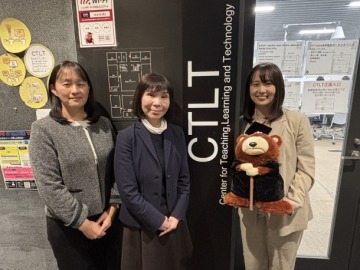Fall Semester 2021 Waseda University Presidential Teaching Award
Subject:Europe and Asia(E)
BACON, Paul Martyn
In “Europe and Asia (E)”, a course offered by the Graduate School of Asia-Pacific Studies (GSAPS), flipped classroom methods are actively used to encourage students’ interactive participation. Professor Baconplaces particular emphasis on the use of response notes. This is an effective methodfor students to prepare for the class, and alsofor the professor to maintain high quality discussions and toencourage the participation of all students.
With the traditional classroom as its base, the second half of the course shifts mainly to student presentations
This course was taken by 16 to 17 students in the fall semester of 2021 and was offered in an online format. The course was taught entirely in English, and many students were from overseas, with a few students taking the course from abroad. Although some students had to deal with time differences between their place of residence and Japan, it did not cause problems because the class structure centered on the flipped classroom, which will discussed later.
The course is characterized by a class structure that encourages critical thinking and active participation by students while taking a traditional teaching style. The first half of the 15 lectures begin with Professor Bacon’s lecture. The 6th through 14th classes transitions to student-led classes, with each class beginning with student presentations. Depending on the number of students enrolled, the presentation will be given by one or two students in each class session. The assigned student presenter(s) will upload their presentation slides to Moodle in advance. Other students will read the slides and prepare a response note. These response notes are 500-600 words in length, and must be uploaded the evening before class to Moodle. Students are to summarize the core points of the readings and to prepare questions they may have. This teaching method of having students prepare presentations and response notes in advance is an example of a “flipped classroom”. The professor the reads through all of the presentations and response notes. This allows the professor to see what the students are focusing on, what they don’t understand, and how they are interpreting the readings. The professor can also identify mistakes students might be making in their understanding of the readings, which could then be incorporated into the class. The class was then conducted in real-time online via Zoom.
“The quality of the first couple of presentations sets an important precedent for subsequent presenters, so I have them give solid presentations. I always allocate a quite substantial part of the student grade to the presentation, 35%, and this means that students have to take the task seriously, and create a strong presentation. Finally, it is important to be strict with deadlines for students, and also with the way in which you deal with latecomers or insufficiently frequent attenders.”
The 15th final class was purposely left open for review and was flexible to accommodate the students’ interests and current events. Students were required to submit a 4,000-word paper at the end of the term. The evaluation was based on the following ratios: 35% for the final paper, 35% for substantial presentation on class readings, and 30% for engagement.
In the student course evaluation, the average score for “Overall, this course was beneficial.” was 5.91 points out of 6 points, which was very high. Some examples of student comments are the following: “It allows us to actively participate in discussions which helps to enhance our understanding of the class material” and “I like how interactive everyone in the class is”. This indicates that the class was designed to encourage active discussions and that the interactive class progression led to high evaluations form the students.
Use response notes to maintain the quality of the class and demonstrate how to discuss critically
Professor Bacon believes that these lesson designs, such as using flipped classroom methods, are effective whether the class is online or face-to-face. The professor cites the following three points as particularly important. The first point is the quality of the teaching materials; second, critical thinking; and third, pre-class content. “The younger generation of students wants to talk, and they want to communicate with each other. It is not so hard to create an environment where people talk, but it is very important to have quality materials. I also use response notes to maintain the quality of the discussions. Students need to learn how to disagree with someone in a respectful, and non-personal, way. This is an interpersonal skill and very important for students who are going to work internationally.”
It often happens that students who are native English speakers, fluent in English, or have strong personalities dominate the discussions. Professor Bacon believes this can also be avoided by writing response notes. “I read the response notes in advance so I know who has what opinion. For example, if one student makes a particular argument in a comment, I can ask a second student who I know disagrees with the first student to make a contribution to the discussion. This problem often occurs even between native speakers, and response notes can be used efficiently even in such cases. I think it is a great way to help Waseda’s Japanese students, who are smart but often quiet for various reasons.”
My passion as a researcher leads to my passion for teaching
Professor Bacon considers himself more of a researcher than a teacher. “My passion for teaching comes from my research. Personally, I’m very interested in issues such as how to deal with new ideas. If this class was well-received, it was because I thought out the structure of the class. I am not in a position to make any comments on Japanese education, but if I could make one comment, I would say that GSAPS provides a very high-quality education among Waseda University’s graduate schools. The School is very rigorous in its evaluation of students, and at the same time, it publishes its teaching assessments. I think this is very healthy for an educational institution.”






